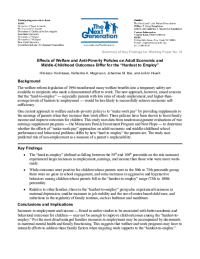Effects of Welfare and Anti-Poverty Policies on Adult Economic and Middle-Childhood Outcomes Differ for the "Hardest to Employ"
Summary of Key Findings for Working Paper No. 12
Background
The welfare reform legislation of 1996 transformed many welfare benefits into a temporary safety net available to recipients who made a demonstrated effort to work. The new approach, however, raised concern that the “hard-to-employ” — especially parents with low rates of steady employment, and higher-than-average levels of barriers to employment — would be less likely to successfully achieve economic self-sufficiency.
One current approach to welfare and anti-poverty policy is to “make work pay” by providing supplements to the earnings of parents when they increase their work effort. These policies have been shown to boost family income and improve outcomes for children. This study uses data from random assignment evaluations of two earnings supplement programs — the Minnesota Family Investment Program and New Hope — to determine whether the effects of “make-work-pay” approaches on adult economic and middle-childhood school performance and behavioral problems differ by how “hard to employ” the parents are. The study uses predicted risk of non-employment as a measure of a parent’s employability.
Key Findings
- The “hard-to-employ” (defined as falling between the 50th and 100th percentile on the risk measure) experienced larger increases in employment, earnings, and income than those who were more work-ready.
- While outcomes were positive for children whose parents were in the 50th to 75th percentile group, there were no gains in school engagement, and some increases in aggressive and hyperactive behaviors among children whose parents fell in the “hardest-to-employ” range (75th to 100th percentile).
- Relative to other families, those in the “hardest-to-employ” group also experienced increases in maternal depression, smaller increases in job stability and the use of center-based child care, and reductions in the regularity of family routines, such as bedtimes and mealtimes.
Conclusions and Implications
Increases in employment and income — found in earlier studies to be associated with better academic and behavioral outcomes for children — may not be enough to improve child outcomes among the “hardest-to-employ.” For the most disadvantaged families increases in employment may be accompanied by decrements in maternal mental health and family functioning. This suggests that welfare and work programs may have to intensify efforts to address these family factors when targeting work supports to the “hardest-to-employ.”






